Want to know about the planet Mars? The fourth planet of the solar system has always attracted human attention, like the term the “Red Planet.” Open expanses, reddish dust-like with signs of life on Mars make this place the next best border to control.
But how long does going to Mars actually take? The answer is far more complicated. The relative positions of Earth and Mars, the speed of the spacecraft, and basically the kind of mission are some factors involved.
So, in this article, let’s analyze what Mars mission is all about and try to find out some factors in travel time, as well as possible and real Mars missions.
Distances Bringing Earth Closer to Mars

It’s all about the distance between Mars and Earth, and hence the amount of time it takes to travel to Mars varies based on the distance separating the two planets. The Earth and Mars are planets of our solar system that revolve around the same star. Their positions are quite alike yet constantly change.
- Closest approach: Earth and Mars distance approximately 54.6 million kilometers or 33.9 million miles.
- Maximum distance: The distance between any two planets is 401 million kilometers at maximum separation on opposite sides of the sun.
- Average Distance: In total, the distance between Mars and Earth is 225 million kilometers.
- Because this distance can change overnight, the time taken to travel to Mars depends on how fast someone is moving.
Orbital Mechanics and the Transfer Windows

One such principle is orbital dynamics that plagues the entire aspect of reaching Mars. Space travelling is more than just pointing a rocket in the right direction and firing it. In orbiting the sun, both Earth and Mars require great speeds, and hence a space shuttle must move along certain paths to reach its destination. We would label such a transfer orbit as a Hohmann orbit that happens to be the most cost-effective and the most efficient way to Mars. This elliptical orbit intersects the Earth and Mars orbits.
A spacecraft is thus sent from the Earth at a certain time to catch up to their orbits. Time possible to send this spacecraft is, therefore, termed as launch window, and a good one comes into existence about once every 26 months, depending on how the planets are positioned.
If it is missed, traveling would take a lot longer and consume considerably more fuel. On average, an onset of the Hohmann transfer orbit takes about 9 months although it may be a little longer or on the contrary, a little bit shorter, depending on mission requirements.
How Quickly Can We Travel?
The speed of the probe will also reduce the time that it takes to go to Mars.
Propulsion Types: Chemically propelled systems, such as rockets, are always velocity-limited.
Yet could allow humans one day to travel quickly over vast distances in the minor time span by “ion propulsion,” one of possible technologies in space exploration. Deep Space 1, a spacecraft built by NASA to demonstrate the use of ion.
propulsion, established efficient fuel utilization guarantees accomplishment of further and faster distances. Currently, for all manned Mars-worthy missions, propulsion remains the dominant method.
Time Taken For The Past Mars Missions
Numerous probes for Mars have been sent with each having its differing technological setup and mission intent that made it either longer or shorter to carry out its objective.
- Mariner 4 could be called the first spacecraft to reach Mars, which took 28 days to get to the planet.
- Viking 1 was about an 11-month journey to Mars for Viking 1-a Mars mission with a Transporter and Lander.
- Mars Odyssey (in 2001): The crew completed their work in 200 days to reach Mars, and the space shuttle is still a working spacecraft.
- Mars Science Laboratory (2011): For nine months, they flew. During the time the craft was being launched, the majority of missions ended anywhere from 6 to 11 months.
Can We Minimize the Duration of Travel Time?
Today’s missions to Mars can last about 6 to 9 months depending on the approach, but there are some promising advanced propulsion innovations available that would reduce this time drastically. Some possible methods would be:
- Nuclear Thermal Propulsion: Such a propulsion system, which heats the propellant with a nuclear reactor, perhaps would cut mission length to Mars in half. NASA has researched nuclear thermal propulsion for many years, even before starting future Mars missions for which this propulsion mode is critical.
- Plasma Rockets: A full 39 days was spent traveling to Mars under VASIMR Variable Specific Impulse Magneto plasma Rocket. In plasma rocket technology, magnetic fields produce plasma or ionized gas.
- Solar Sails: Propelling a spaceship under light pressure forward, such as employing solar sails, is not yet where it should be; the Insertion method may produce sustained acceleration over the long haul and, hence, cut down time travel.
All these propulsion technologies can improve human space travel to Mars, making it safer, faster, and feasible.
Challenges Of A Long Journey
A long journey to Mars poses many challenges, even if it can be done in a little while. A long trip lasting 6-9 months will mean that astronauts will be in space for a longer time, thereby exposing them to various health risks.
Radiation Exposure: With no atmosphere, astronauts are more exposed to cosmic radiation. If people stay for an extended period, then these radiations can be responsible for a host of cancer pathologies and other diseases.
Muscle And Bone Loss: Astronauts in space struggle with muscle loss and bone loss due to the lack of supportive effects of microgravity as experienced on Earth. Exercise can counteract some of the de-training effects; nonetheless, these factors are a major concern during long-duration spaceflight.
Psychological Pressure: Martians will cause some physical or mental pain to the astronauts, being alone and locked inside a module far from home. Thus, maintaining their mental health while on the mission to Mars will be quite difficult and will need intensive preparations.
Return Trip Considerations
The fast and reliable return to Earth in case of failure is another vital factor concerning Mars missions. Each human-crewed mission is a mission that takes place not only on Mars but also to return back to where the craft was launched from. This includes consideration of spacecraft fuel, food, and resources and the time of the return launch window.
And just like getting to Mars, the return would depend on which planets are lined up and would take about the same time. The crew would stay on the planet for about 18 months, waiting until Earth and Mars align correctly, before flying back home in some proposed mission architectures like the Mars Direct proposal for NASA.
Conclusion
Going to Mars is a huge and lengthy deal that is subject to significant interference from the power and engines of the spacecraft as well as the planetary setup for its journey. With the current technology, one can reach Mars in about six to nine months, but through technicolor enhancements, this trip could stand reduced in time significantly. Whereas its possibility seemed like a dream to us just yesterday, the vision of going to Mars and settling there now stands at the razor edge of humanity’s next giant leap.
Not far on its path will be until such a time when Mars shall be finally trodden upon and examined up and down by men.
FAQ
How long does a trip to Mars take?
According to NASA, a round trip to the Red Planet will take about nine months.
Is oxygen present in the atmosphere of Mars?
Mars does have some oxygen, but not sufficiently so that a person could walk outdoors and breathe directly.
When is it going to be for the human foot on Mars?
NASA says it aims to fly astronauts to Mars in the early 2030s as their technology makes that possible.
Can a man exist on Mars?
Given the very low air pressure, the radiation, and the atmosphere with only 0.16% oxygen, neither humans nor the majority of known life forms can survive on the surface.
Can life exist on Mars?
After finding cosmic radiation levels at different depths on Mars, it could be inferred that in time, any form of life would be completely destroyed by lethal doses of cosmic radiation within the first few meters of the surface.




